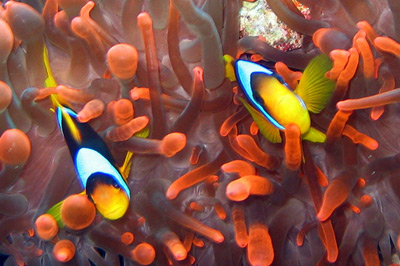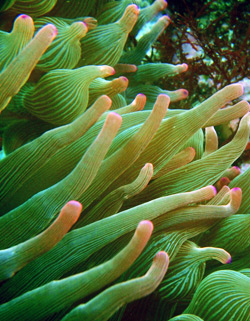The bubble-tip anemone (Entacmaea quadricolor), or BTA, is justifiably popular in the marine aquarium hobby, being relatively hardy and easy to keep as anemones go as well as being a suitable host anemone for many clownfish species. But to horribly misquote legendary singer Dion DiMucci, “it’s the type of nem that likes to roam around”—particularly when it’s getting settled into a new system or decides it’s unhappy with its placement in an established one.
The problem with an anemone going parading around its aquarium is that anytime it does so, it has the potential of blundering into equipment or other sessile invertebrates with potentially injurious (or even fatal) consequences. Thus, any system housing a BTA must be designed or modified to reduce the risk of accidental injury or harmful interspecific encounters.
Here are several important factors to consider when BTA-proofing your tank:
Crowded reef tanks aren’t ideal for BTAs
People do keep BTAs in reef systems among various corals and other sessile invertebrates. However, as alluded above, this can prove problematic if the anemone goes roaming, as it may sting or be stung by any inverts it encounters in its travels (though not all corals are equally sensitive to the sting of a BTA and vice versa). Not to mention, problems with allelopathy (chemical warfare) among inverts tend to be much greater in mixed reefs. The best housing for a BTA is a good-sized system dedicated specifically to its needs.
(If you’ve had long-term success keeping a BTA in a mixed reef, we’d love to hear how you managed it in the comment section below.)
Pumps and powerheads are problematic
Submersible pumps and powerheads are among the biggest offenders when it comes to injuring/killing wandering nems, so the intakes of these devices must be screened off with sponge, foam, or a similar material. The screening material must not only create a physical barrier, but also diffuse the suction so the anemone’s tentacles or foot can’t get trapped on the intake or actually get sucked inside the pump.
Keep in mind that the material protecting the intake will trap a lot of debris, so you’ll need to remove and rinse it frequently to prevent clogging and the subsequent reduction of water flow.
Heaters can be harmful
Aquarium heaters can also present a major health hazard to nems. To prevent a wandering BTA from contacting or attaching itself to a heater and being severely scalded, it’s best to place the heater down in a sump rather in the main display tank. If that’s not an option, the heater needs to be isolated in such a manner that the anemone can’t reach it, but the water can still easily flow around it—for example, by inserting the heater in a section of PVC pipe with holes drilled through it.
Stable, optimal conditions discourage roaming
Once a BTA settles into a suitable location in its new home (typically with its foot attached down inside a rocky crevice), it will be more inclined to remain in that location if conditions are kept stable and optimal. So be sure to guard against issues such as:
- Fluctuations in temperature, pH, specific gravity, or other water parameters
- Gradually deteriorating water quality
- Gradually declining light intensity/shifting spectral characteristics (change bulbs/tubes on an appropriate schedule, clean cover glasses, etc.)
- Corals encroaching on the anemone as their colonies increase in size or spread from rock to rock (another argument for giving anemones a dedicate tank)
- Nippy fish tankmates
These and any other influences that impact the stability of the system or alter living conditions for the worse can prompt a BTA to detach and go roaming in search of “greener pastures,” potentially putting itself or tankmates at risk in the process.




